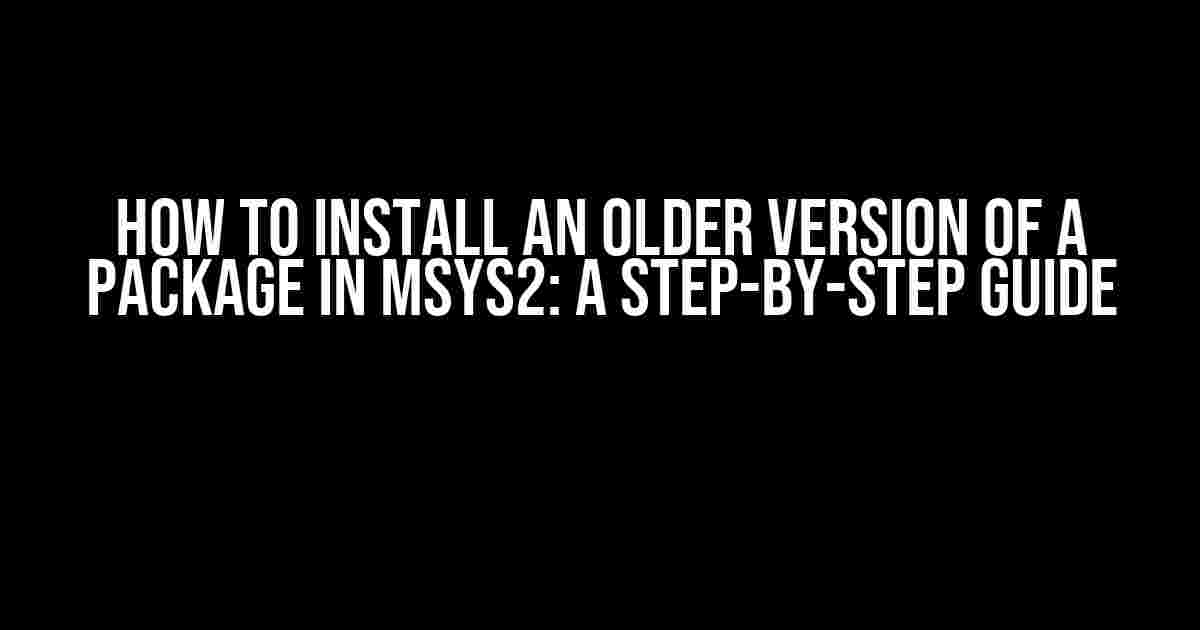Are you tired of dealing with compatibility issues or bugs in the latest version of a package in MSYS2? Look no further! In this article, we’ll show you how to install an older version of a package in MSYS2, so you can get back to coding without worrying about version-related headaches.
Why Install an Older Version of a Package?
Sometimes, the latest version of a package might not be compatible with your project’s requirements or might introduce new bugs that affect your workflow. In such cases, installing an older version of the package can be a lifesaver. Additionally, some projects might require specific versions of packages to function correctly, making it essential to know how to install older versions.
Prerequisites
Before we dive into the installation process, make sure you have:
- A working MSYS2 environment installed on your system.
- A package manager like pacman or mingw-get installed and configured.
- “Downgrade” privileges enabled for the package manager (more on this later).
Step 1: Check the Package Version History
To install an older version of a package, you need to know the available versions. You can do this using the package manager. Open a terminal in MSYS2 and run the following command:
pacman -Ss <package_name>Replace <package_name> with the name of the package you want to install an older version of. This command will display a list of available versions, including the current and older ones.
Step 2: Enable Downgrade Privileges
By default, pacman and mingw-get don’t allow downgrading packages. To enable downgrade privileges, you need to edit the package manager’s configuration file. Open a terminal and run the following command:
sudo nano /etc/pacman.confFor mingw-get, use:
sudo nano /etc/mingw-get.confIn the configuration file, uncomment the following line by removing the “#” symbol at the beginning:
#DowngradeSave the changes and exit the editor.
Step 3: Install the Older Version of the Package
Now that you have the available versions and downgrade privileges enabled, you can install the older version of the package. Use the following command:
pacman -U <package_name>-<version>Replace <package_name> with the name of the package and <version> with the desired older version.
For example, to install version 1.2.3 of the “libftdi” package, use:
pacman -U libftdi-1.2.3Confirm the installation by pressing “Y” when prompted.
Step 4: Verify the Installation
After the installation, verify that the older version of the package has been installed correctly. You can do this by checking the package version:
pacman -Qi <package_name>This command will display information about the installed package, including its version.
Common Issues and Solutions
You might encounter some issues during the installation process. Here are some common problems and their solutions:
| Error: “Failed to commit transaction (conflicting files)” | Run pacman -S --force <package_name> to force the installation. |
| Error: “Package not found” | Check the package name and version for typos. Try installing a different version or check if the package is available in the MSYS2 repositories. |
| Package dependencies not met | Run pacman -S --deps <package_name> to install the required dependencies. |
Conclusion
Installing an older version of a package in MSYS2 might seem like a daunting task, but with the right steps, it’s a breeze. By following this guide, you can overcome compatibility issues and get back to coding with your preferred version of a package. Remember to enable downgrade privileges and verify the installation to ensure a smooth process.
Happy coding!
Additional Tips and Tricks
Here are some additional tips to keep in mind when working with packages in MSYS2:
- Keep your MSYS2 environment up-to-date by running
pacman -Syuregularly. - Use
pacman -Ql <package_name>to list the files installed by a package. - Use
pacman -R <package_name>to remove a package and its dependencies. - Use
mingw-get install <package_name>to install packages using mingw-get.
Stay tuned for more MSYS2 tutorials and guides!
Frequently Asked Question
Are you stuck in the dilemma of installing an older version of a package in MSYS2? Worry not, dear developer, for we’ve got you covered! Here are the answers to your burning questions.
How do I find the version history of a package in MSYS2?
You can use the pacman command to find the version history of a package. Simply run `pacman -Qi
How do I install a specific version of a package in MSYS2?
To install a specific version of a package, use the following command: `pacman -U
Where do I find the older version of the package files in MSYS2?
You can find older version of package files in the MSYS2 archive repository. The archive repository is located at `
Can I install an older version of a package even if it’s not available in the MSYS2 repository?
Yes, you can install an older version of a package even if it’s not available in the MSYS2 repository. You can download the package file from an external source, such as the package maintainer’s website, and then install it using the `pacman -U` command.
What are the potential risks of installing an older version of a package in MSYS2?
Installing an older version of a package can pose security risks if the older version has known vulnerabilities. Additionally, older versions of packages may not be compatible with newer versions of other packages, which can cause dependency issues. Always exercise caution when installing older versions of packages and ensure you’re aware of the potential risks.


